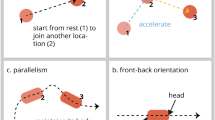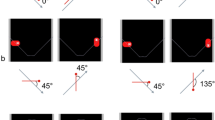Abstract
Movement recognition is central to visual perception and cognition, yet its origins are poorly understood. Can newborn animals encode and recognize movements at the onset of vision, or does this ability have a protracted developmental trajectory? To address this question, we used an automated controlled-rearing method with a newborn animal model: the domestic chick (Gallus gallus). This automated method made it possible to collect over 150 test trials from each subject. In their first week of life, chicks were raised in controlled-rearing chambers that contained a single virtual agent who repeatedly performed three movements. In their second week of life, we tested whether chicks could recognize the agent’s movements. Chicks successfully recognized both individual movements and sequences of movements. Further, chicks successfully encoded the order that movements occurred within a sequence. These results indicate that newborn visual systems can encode and recognize movements at the onset of vision and argue for an increased focus on automated controlled-rearing methods for studying the emergence of perceptual and cognitive abilities.




Similar content being viewed by others
References
Bateson P (ed) (2000) What must be known in order to understand imprinting? The evolution of cognition. The MIT Press, Cambridge, MA
Bertenthal BI, Proffitt DR, Cutting JE (1984) Infant sensitivity to figural coherence in biomechanical motions. J Exp Child Psychol 37:213–230
Buttelmann D, Carpenter M, Call J, Tomasello M (2007) Enculturated chimpanzees imitate rationally. Dev Sci 10:F31–F38
Davey MG, Tickle C (2007) The chicken as a model for embryonic development. Cytogenet Genome Res 117:231–239
Endress A, Wood JN (2011) From movements to actions: two mechanisms for learning action sequences. Cogn Psychol 63:141–171
Espinosa JS, Stryker MP (2012) Development and plasticity of the primary visual cortex. Neuron 75:230–249
Evans CS, Marler P (1991) On the use of video images as social stimuli in birds: audience effects on alarm calling. Anim Behav 41:17–26
Evans CS, Evans L, Marler P (1993) On the meaning of alarm calls: functional reference in an avian vocal system. Anim Behav 46:23–38
Fox R, Mcdaniel C (1982) The perception of biological motion by human infants. Science 218:486–487
Gavornik JP, Bear MF (2014) Learned spatiotemporal sequence recognition and prediction in primary visual cortex. Nat Neurosci 17:732–737
Grandin T, Johnson C (2005) Animals in translation. Scribner, New York
Heider F (1958) The psychology of interpersonal relations. Wiley, New York
Horn G (2004) Pathways of the past: the imprint of memory. Nat Rev Neurosci 5:108–120
Jarvis ED et al (2005) Avian brains and a new understanding of vertebrate brain evolution. Nat Rev Neurosci 6(2):151–159
Karten H (2013) Neocortical evolution: neuronal circuits arise independently of lamination. Curr Bio 23:R12–R15
Kruschke JK (2010) What to believe: Bayesian methods for data analysis. Trends Cogn Sci 14:293–300
Li N, DiCarlo JJ (2008) Unsupervised natural experience rapidly alters invariant object representation in visual cortex. Science 321:1502–1507
McQuoid LM, Galef BG Jr (1993) Social stimuli influencing feeding behaviour of Burmese red jungle fowl: a video analysis. Anim Behav 46:13–22
Newtson D, Engquist G (1976) The perceptual organization of ongoing behavior. J Exp Soc Psychol 12:436–450
Shanahan M, Bingman VP, Shimizu T, Wild M, Gunturkun O (2013) Large-scale network organization in the avian forebrain: a connectivity matrix and theoretical analysis. Front Comput Neurosci 7(89):1–17
Simion F, Regolin L, Bulf H (2008) A predisposition for biological motion in the newborn baby. PNAS 105:809–813
Smith CL, Evans CS (2008) Multimodal signaling in fowl, Gallus gallus. J Exp Biol 211:2052–2057
Stokes AW, Williams HW (1972) Courtship feeding in Gallinaceous birds. Auk 89:177–180
Suchak M, de Waal FBM (2012) Monkeys benefit from reciprocity without the cognitive burden. PNAS. doi:10.1073/pnas.1213173109
Urgolites ZJ, Wood JN (2013) Visual long-term memory stores high-fidelity representations of observed actions. Psychol Sci 24:403–411
Vallortigara G, Regolin L (2006) Gravity bias in the interpretation of biological motion by inexperienced chicks. Curr Biol 16:R279–R280
Vallortigara G, Regolin L, Marconato F (2005) Visually inexperienced chicks exhibit spontaneous preference for biological motion patterns. PLoS Biol 3:1312–1316
Warneken F, Tomasello M (2006) Altruistic helping in human infants and young chimpanzees. Science 311:1301–1303
Wood JN (2007) Visual working memory for observed actions. J Exp Psychol Gen 136:639–652
Wood JN (2013) Newborn chickens generate invariant object representations at the onset of visual object experience. PNAS 110:14000–14005
Wood JN (2014a) Newly hatched chicks solve the visual binding problem. Psychol Sci 25:1475–1481
Wood JN (2014b) Characterizing the information content of a newly hatched chick’s first visual object representation. Dev Sci. doi:10.1111/desc.12198
Wood JN, Glynn DD, Philips B, Hauser MD (2007) The perception of rational, goal-directed action in non-human primates. Science 317:1402–1405
Woodward AL (1998) Infants selectively encode the goal object of an actor’s reach. Cognition 69:1–34
Woodward AL, Sommerville JA (2000) Twelve-month-old infants interpret action in context. Psychol Sci 11:73–77
Acknowledgments
We thank Samantha M. W. Wood for assistance on this manuscript and Aditya Prasad, Tony Bouz, and Lynette Tan for their assistance building the controlled-rearing chambers. This research was funded by National Science Foundation CAREER Grant BCS-1351892 to J. N. W. The experiments were approved by The University of Southern California Institutional Animal Care and Use Committee.
Conflict of interest
The authors declare that they have no conflict of interest.
Author information
Authors and Affiliations
Corresponding author
Electronic supplementary material
Below is the link to the electronic supplementary material.
Supplementary material 1 (MOV 3760 kb)
Supplementary material 2 (MOV 2310 kb)
Supplementary material 3 (MOV 3000 kb)
Rights and permissions
About this article
Cite this article
Goldman, J.G., Wood, J.N. An automated controlled-rearing method for studying the origins of movement recognition in newly hatched chicks. Anim Cogn 18, 723–731 (2015). https://doi.org/10.1007/s10071-015-0839-3
Received:
Revised:
Accepted:
Published:
Issue Date:
DOI: https://doi.org/10.1007/s10071-015-0839-3




